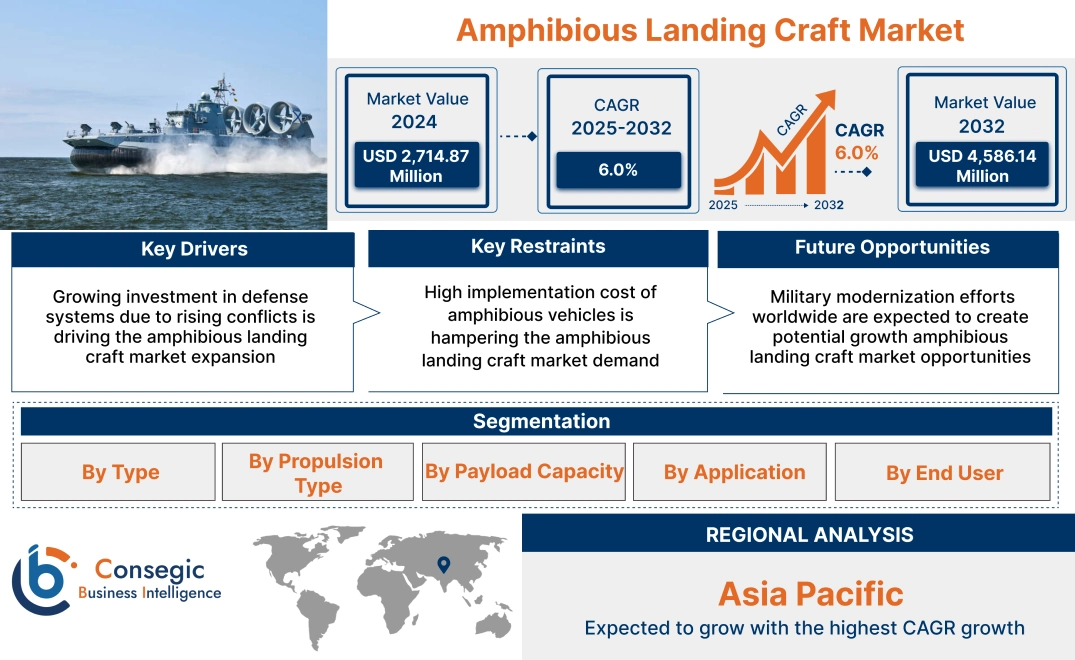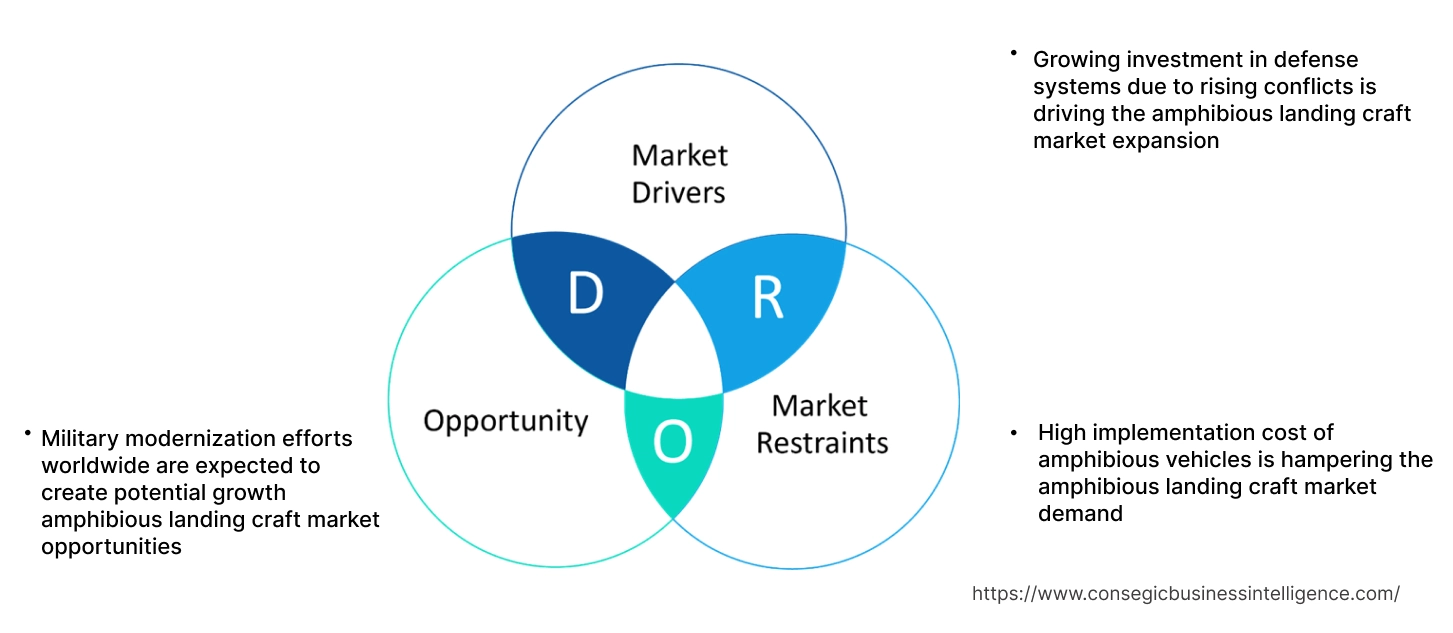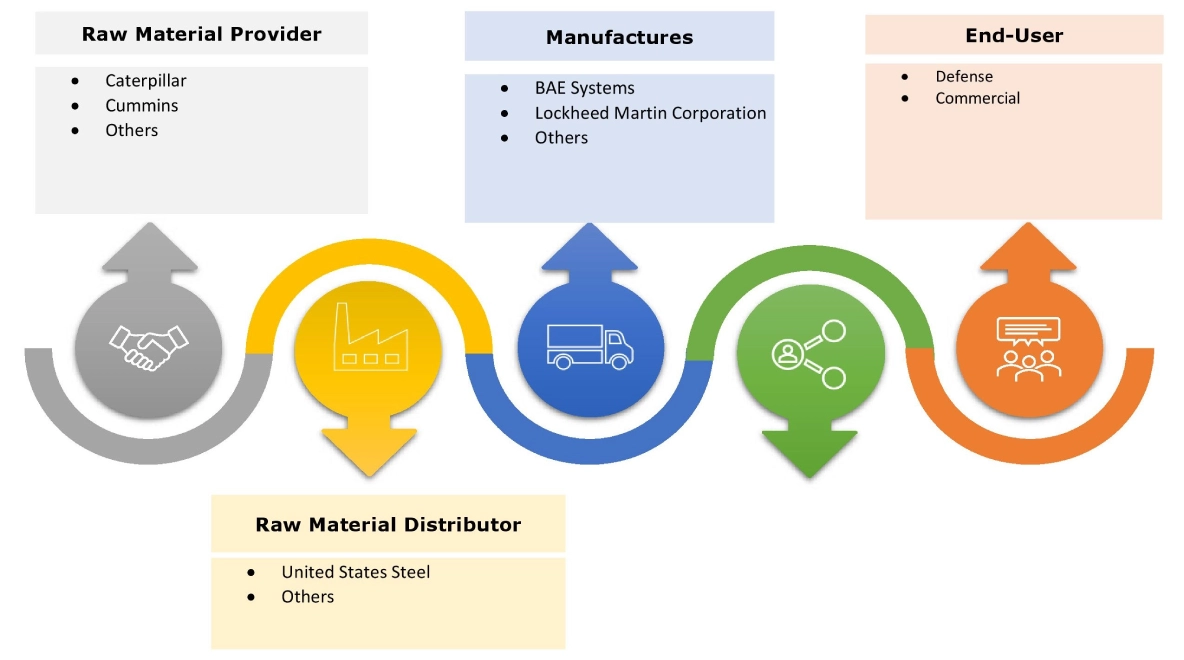- Summary
- Table Of Content
- Methodology
Amphibious Landing Craft Market Size:
Amphibious Landing Craft Market Size is estimated to reach over USD 4,586.14 Million by 2032 from a value of USD 2,714.87 Million in 2024 and is projected to grow by USD 2,873.97 Million in 2025, growing at a CAGR of 6.0% from 2025 to 2032.
Amphibious Landing Craft Market Scope & Overview:
An amphibious landing craft is a transport vehicle capable of operating on land, water, and even underwater. Commonly referred to as an amphibian, this versatile vehicle is utilized for defense due to its various applications in military and surveillance operations. Additionally, the vehicle is increasingly employed in commercial settings for water sports, recreation, and water transportation, attributed to its growing popularity and technological advancements. Furthermore, amphibious excavators are utilized in dredging activities, including the maintenance of riverbeds, swamps, lakes, ponds, and reservoirs, as well as for environmental clean-up efforts and other related tasks.
Key Drivers:
Growing investment in defense systems due to rising conflicts is driving the amphibious landing craft market expansion
In recent years, countries have collaborated to modernize their defense systems and equipment. The primary driver for this modernization is the increasing need for border security and the growing threat of terrorism globally. For instance, the United States, China, Saudi Arabia, and India are enhancing their defense industries by investing significantly in procurement and developing advanced weapon systems. Additionally, all-terrain armored vehicles play a crucial role in operations on both land and water. The maritime sector depends on these vehicles to facilitate the transportation of troops from ships to shore. Furthermore, Amphibious Assault Vehicles (AAVs) are equipped with powerful engines that provide high speed and capability across various terrains. These vehicles also offer advantages in terms of reliability, adaptability, and are armed with weapons and ammunition to ensure effectiveness in combat.
- For instance, in March 2024, the navies of India and the US have involved in extensive joint exercise of ships and aircraft. This phase showcases combat manoeuvres, joint actions, and amphibious operations on the coast of Kakinada. Furthermore, the exercise serves as a platform for showcasing humanitarian assistance and disaster relief (HADR), featuring the participation of aircraft, vehicles, personnel and helicopters from the Rapid Action Medical Teams, Indian Army, and Indian Air Force. Teams from both countries collaborated to conduct an amphibious landing and established a field hospital and a camp for displaced persons, highlighting the anticipated cooperation between the two nations in the aftermath of a natural disaster.
Thus, according to the amphibious landing craft market analysis, the growing investment toward defense systems is driving the amphibious landing craft market size.
Key Restraints:
High implementation cost of amphibious vehicles is hampering the amphibious landing craft market demand
The expense associated with amphibious vehicles have risen with the integration of advanced technology-based systems and equipment. The design of these vehicles can be tailored to specific applications; consequently, the systems must be compatible for both land and water use, which contributes to the overall substantial cost. The engines in these vehicles are distinct from those utilized in land-based vehicles, making them one of the costliest components. Furthermore, the operational expenses for such vehicles are significant. A significant challenge lies in the availability of spare parts. In the defense sector, naval forces rely on these vehicles for transportation from ship to shore. Additional vehicle accessories, including load capacities, safety features, and fire protection systems, further increase the overall costs. These factors are hindering the growth of the amphibious landing craft market.
Future Opportunities :
Military modernization efforts worldwide are expected to create potential growth amphibious landing craft market opportunities
The amphibious landing craft market presents a significant growth opportunity driven by global military modernization initiatives. These vehicles have become essential assets for armed forces, enhancing their operational capabilities. Amphibious vehicles fulfill multiple roles, including troop transport, reconnaissance, and amphibious assaults, offering strategic advantages in various scenarios. As security challenges continue to evolve, the demand for technologically advanced and versatile amphibious vehicles is on the rise. Manufacturers can leverage this opportunity by developing innovative solutions that satisfy the stringent requirements of contemporary military forces. This includes enhancements in vehicle performance, durability, communication systems, and the integration of advanced weaponry and protective features. Additionally, international cooperation and military agreements are expected to positively impact industry growth, as nations increasingly seek to acquire state-of-the-art amphibious equipment to strengthen their defense capabilities against both conventional and irregular security threats.
- For instance, in December 2024, The Chinese navy launch new amphibious assault ship, that can launch fighter jets. The ship is designed to deploy ground troops in landing crafts and provide them with air support. In addition to this, it is also equipped with arrestor technology that enables fighter jets to land on its deck.
Thus, rising military efforts worldwide are driving the amphibious landing craft market opportunities.
Amphibious Landing Craft Market Segmental Analysis :
By Type:
Based on the type, the market is segmented into Landing Craft Mechanized (LCM), Landing Craft Utility (LCU), and Landing Craft Air Cushion (LCAC).
Trends in the Type:
- Continuous technological advancements in amphibious vehicle design, propulsion systems, and materials are propelling market growth.
- Innovations such as enhanced amphibious capabilities, improved speed, and greater payload capacities are modernizing military fleets and encouraging defense forces globally to adopt these vehicles.
The Landing Craft Utility (LCU) segment accounted for the largest revenue in the year 2024.
- The rising threats of piracy, terrorism, and other maritime security issues are amplifying the necessity for versatile and capable vessels, such as LCUs, for coastal patrol, search and rescue, and disaster relief operations.
- LCUs are essential for amphibious operations, facilitating the swift transfer of troops and equipment from sea to shore. The heightened focus on amphibious capabilities by numerous navies is fuelling the demand for these vessels.
- Economic growth and infrastructure development in various coastal areas are generating a need for vessels that can transport heavy equipment and materials, including construction supplies and large machinery.
- These developments would further drive the amphibious landing craft trends during the forecast period.
The Landing Craft Air Cushion (LCAC) segment is anticipated to register the fastest CAGR during the forecast period.
- Landing Craft Air Cushion (LCAC) vessels provide high-speed transportation between ships and shore by employing air cushion technology to glide over water. LCACs are well-suited for quick deployment and logistical support in shallow waters and challenging terrains.
- Naval operations utilize amphibious landing craft for fleet support, logistics, and replenishment missions, facilitating the movement of personnel and supplies between ships at sea or to coastal facilities. Additionally, maritime security operations depend on these vessels for coastal patrols, surveillance, and anti-piracy missions, enhancing the protection of maritime borders and critical infrastructure.
- LCACs demonstrate remarkable payload capacities, enabling the transportation of heavy armor and personnel at high speeds, thus serving as essential assets for naval and marine forces engaged in amphibious assault operations. Their capability to quickly transfer troops and equipment from ship to shore is crucial for achieving tactical surprise and sustaining operational tempo in littoral environments.
- Thus, based on the analysis and trends these factors are driving the amphibious landing craft market size during the forecast period.
By Propulsion Type:
Based on the propulsion type, the market is segmented into Water Jets, Screw Propellers, Diesel Engines, and Others.
Trends in propulsion type:
- Several countries are investing in the modernization of their military forces, particularly in enhancing their amphibious capabilities. This effort is increasing the need for new and upgraded landing craft.
- These vessels play a critical role in counterterrorism operations, especially in coastal and island regions, thereby elevating the necessity for amphibious vehicles.
The diesel engines segment accounted for the largest revenue in the year 2024
- Ongoing advancements in diesel engine technology, including improved fuel efficiency and decreased emissions, are further increasing their attractiveness.
- Diesel engines provide the significant power and torque required for navigating vessels through water and across diverse terrains.
- These engines are designed to endure challenging marine environments and rigorous operational demands, diesel engines are recognized for their durability and resilience.
- Therefore, based on the above amphibious landing craft market analysis, the diesel engines will be dominating the market share.
The water jets segment is anticipated to register the fastest CAGR during the forecast period.
- Water jets offer outstanding manoeuvrability, facilitating precise control in tight spaces and shallow waters. This capability is vital for navigating intricate coastal environments and working in confined areas.
- Water jets allow for operation in shallower waters than traditional propellers, lowering the risk of grounding and enhancing operational flexibility.
- The stealth and manoeuvrability provided by water jets are beneficial for counterterrorism operations in coastal and riverine regions.
- Thus, based on the above analysis and trends such factors are fostering innovation and broadening the market opportunity.
By Payload Capacity:
Based on the payload capacity, the market is segmented into Light-duty, Medium-duty, and Heavy-duty.
Trends in the payload capacity:
- Advancements in materials science, propulsion technology, and automation are facilitating the creation of more efficient and capable landing craft, featuring enhanced payload capacities.
- A heightened focus on sustainability in military operations is promoting the development of more environmentally friendly and fuel-efficient landing craft.
Heavy-duty accounted for the largest revenue share of 38.85% in the year 2024 and is expected to register the highest CAGR during the forecast period.
- Heavy-duty amphibious vehicles are engineered to function in demanding environments, capable of navigating both land and water while carrying substantial payloads. These vehicles are utilized across various sectors, including the military, construction, disaster relief, and exploration.
- Heavy duty amphibious landing crafts have become essential assets in addressing the challenges of evolving security concerns and natural disasters due to their ability to quickly transport personnel, equipment, and supplies.
- These factors would further supplement the amphibious landing craft market trends during the forecast period.
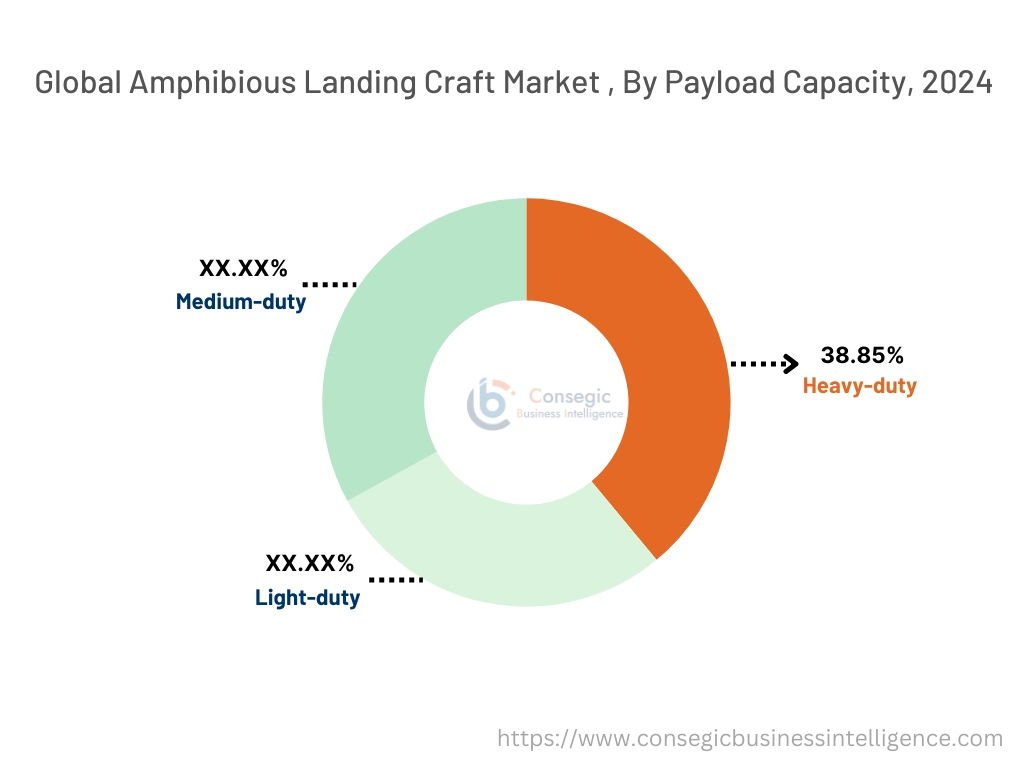
By Application:
Based on application, the market is segmented into Vehicles landing, Troop Transport, Civilian logistics, Coast Guard Functions, Humanitarian Aid and Disaster Relief, Command and Control Operations, Patrolling and Escort, Combat Support, Excavation, and Others.
Trends in the application:
- Amphibious vehicles offer a distinct advantage in search and rescue and surveillance operations, owing to their advanced surveillance and communication systems that facilitate real-time information gathering, reconnaissance, and monitoring of remote terrains, both on land and in water.
- The increasing frequency and severity of natural disasters have escalated the need for vessels capable of responding to humanitarian crises.
- Amphibious vehicles serve as a discreet and adaptable platform for various surveillance applications, including border security, environmental monitoring, and wildlife conservation, due to their access to waterlogged areas. These attributes render amphibious vehicles essential tools for protecting lives and enhancing security.
Troop transport accounted for the largest revenue share of 56.21% in the year 2024 and is expected to register the highest CAGR during the forecast period.
- Modern landing craft feature advanced armor, countermeasures such as electronic warfare suites, and superior seakeeping capabilities to endure enemy fire and function in challenging sea conditions.
- The integration of autonomous navigation systems unmanned aerial vehicles (UAVs), and artificial intelligence (AI) enhances situational awareness, optimizes mission planning, and minimizes personnel risk.
- The use of lightweight and high-strength materials increases payload capacity, decreases weight, and bolsters durability.
- For instance, In November 2024, The U.S. armed forces conducted a rehearsal utilizing a new amphibious combat vehicle in an exercise that involved several marines and sailors. This represents the inaugural instance of an ACV successfully transporting infantry marines to and from a ship during both nighttime and daytime operations. The exercise, termed Quarterly Underway Amphibious Readiness Training (QUART), was conducted to enhance the practice of the country’s marine corps and navy and amphibious capabilities to.
- These factors and trends would further drive the market during the forecast period.
By End User:
Based on end user, the market is segmented into Defense and Commercial.
Trends in the end user:
- End users require landing craft capable of performing various functions, including troop, vehicle, and cargo transport, to enhance operational flexibility and cost efficiency.
- Interoperability with other military assets, such as helicopters, aircraft, and ground vehicles are crucial for amphibious operations.
The defense segment accounted for the largest revenue in the year 2024
- The defense platform of the amphibious vehicle market is essential for providing specialized military vehicles. These vehicles, engineered for multiple functions such as troop transport, reconnaissance, and amphibious assaults, are equipped with advanced weaponry, communication systems, and armor.
- They can swiftly navigate various terrains, including rivers, lakes, marshes, and coastal regions, ensuring a prompt response to potential threats or crises. Their ability to transition seamlessly between land and water makes them a valuable component of modern military forces, serving as a versatile and adaptable asset to effectively tackle security challenges.
- For instance, in October 2024, the Indian Defense Ministry, announced the collaboration with Chowgule & Company Pvt., to procure six air cushion amphibious vehicles for the Indian Coast Guard. These amphibious vehicles, known as Hovercrafts, will be procured under the Buy type, and will be manufactured in India for the first time, aligning with the government's 'Aatmanirbhar Bharat' vision and marking a significant advancement in the nation's shipping sector. The procurement aims to enhance the capabilities of the Indian Coast Guard and underscores the heightened emphasis on maritime security.
- These developments and analysis would further supplement the amphibious landing craft market during the forecast period.
The commercial segment is anticipated to register the fastest CAGR during the forecast period.
- The rising incidence and intensity of natural disasters are necessitating enhanced disaster response capabilities.
- The heightened focus on passenger comfort and safety features includes comfortable seating, air conditioning, and advanced safety systems.
- Amphibious landing craft support construction initiatives in coastal and riverine regions, such as the construction of bridges, pipelines, and coastal infrastructure.
- These factors would further supplement the amphibious landing craft market growth during the forecast period.
Regional Analysis:
The global market has been classified by region into North America, Europe, Asia-Pacific, MEA, and Latin America.
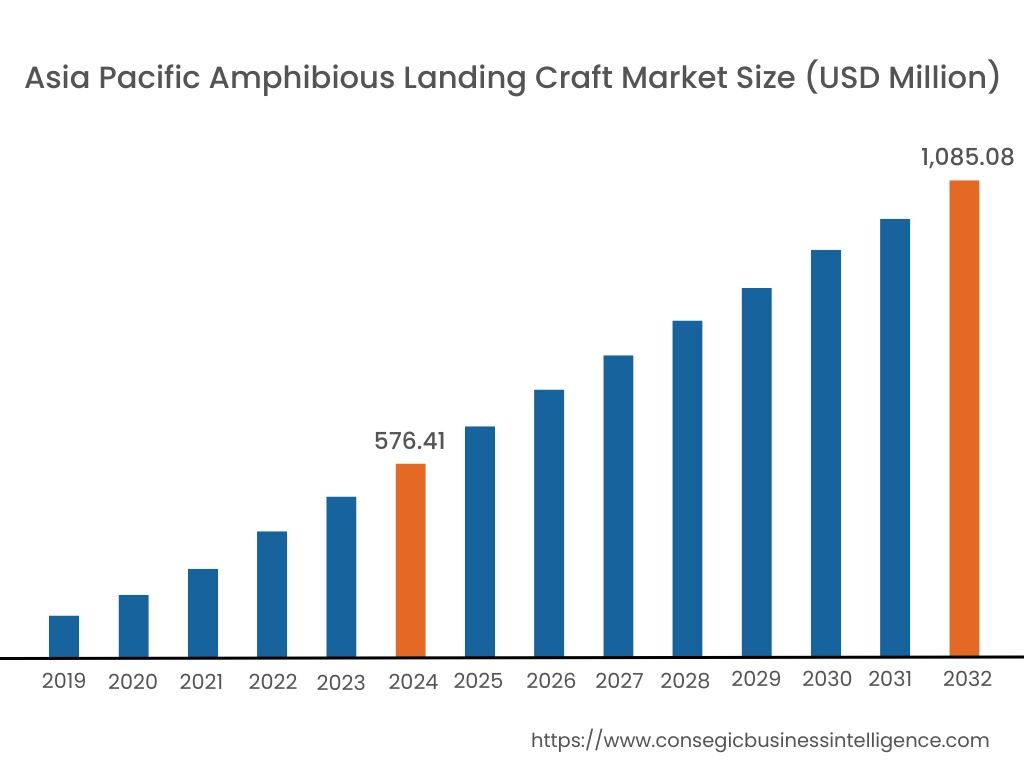
Asia Pacific amphibious landing craft market expansion is estimated to reach over USD 1,085.08 Million by 2032 from a value of USD 576.41 Million in 2024 and is projected to grow by USD 616.00 Million in 2025. Out of this, China amphibious Landing Craft industry accounted for the maximum revenue share of 31.19%. The swift economic progression and heightened defense budgets in the region have generated a robust need for advanced military assets capable of adapting to diverse scenarios. As tensions and territorial disputes continue in the region, countries are significantly enhancing their defense capabilities, further amplifying the necessity for amphibious vehicles. Furthermore, the flourishing tourism industry in the Asia-Pacific attracts an increasing number of travelers seeking unique and adventurous experiences. The rising popularity of amphibious vehicles, which allow tourists to engage in both land and water excursions in destinations such as Bali, Phuket, and Sydney, is anticipated to drive a substantial increase in need for such tourist vehicles, resulting in broader regional amphibious landing craft market share and opportunities in the coming years.
- For instance, in November 2024, The Japanese Self-Defense Force has introduced a new class of amphibious vessels designed to support a unit dedicated to maritime logistics for resupplying and reinforcing its southwestern islands. As stated by the Ministry of Defense, this new provisional unit will encompass personnel from all three branches of the Japan Self-Defense Force.
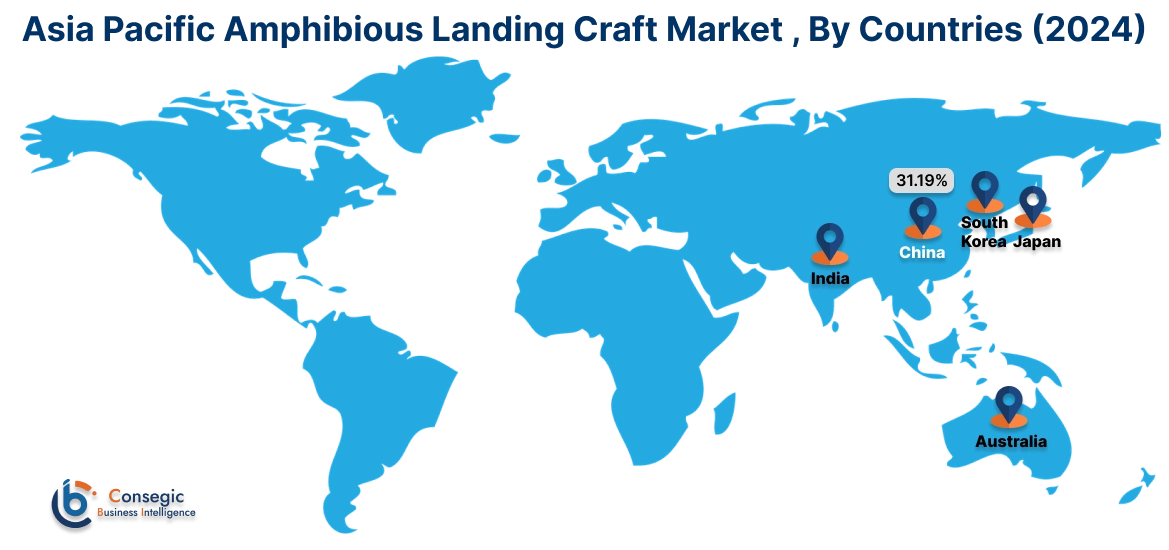
North America amphibious landing craft market growth is estimated to reach over USD 1,666.60 Million by 2032 from a value of USD 614.77 Million in 2024 and is projected to grow by USD 1,066.31 Million in 2025. In the defense sector, North America exhibits a robust demand for amphibious vehicles, driven by requirements for swift reconnaissance, maritime security, and troop deployment. The United States notably focuses on military modernization and sustaining a strong presence in various global theaters. Amphibious vehicles are vital for the readiness and effectiveness of the U. S. Marine Corps, facilitating amphibious assaults and operations in difficult terrains and coastal areas. Additionally, these vehicles are crucial for the U. S. Coast Guard, supporting search and rescue missions, border security, and maritime law enforcement. These factors would further supplement the regional amphibious landing craft market share and opportunities during the forecast period.
- For instance, in January 2022, The S. Marine Corps has signed a contract with BAE Systems for the full-rate production of the additional batch of amphibious vehicles, which are specialize in combat applications. This contract encompasses a total of 33 vehicles, valued at USD 169 million.
As per the amphibious landing craft industry analysis, Several European nations are investing in the modernization of their military capabilities, notably their amphibious landing craft fleets. This initiative is motivated by geopolitical uncertainties and the necessity of sustaining a robust naval presence. Additionally, the rising threat of piracy, terrorism, and illicit activities at sea is fueling the need for amphibious landing craft for maritime security operations in Latin America. These vessels are capable of patrolling coastal waters, conducting search and rescue missions, and responding to emergencies. Furthermore, the MEA region is a significant producer of oil and gas. Amphibious landing craft facilitate offshore operations by transporting personnel and equipment to and from offshore platforms.
Top Key Players and Market Share Insights:
The global amphibious landing craft market is highly competitive with major players providing solutions to the national and international markets. Key players are adopting several strategies in research and development (R&D), product innovation, and end-user launches to hold a strong position in the market. Key players in the amphibious landing craft industry includes-
- Damen Shipyards (Netherlands)
- BMT (U.K.)
- CNIM Industrial Systems (France)
- Griffin Hoverwork (U.K.)
- Marine Alutech Oy Ab (Finland)
- Lockheed Martin Corporation (U.S.)
- Textron Systems (U.S.)
- PDL Marine (U.K.)
- L3 Technologies, Inc. (U.S.)
- Wetland Equipment Company (U.S.)
- BAE Systems (U.K.)
Recent Industry Developments :
Agreement:
- In September 2022, WFEL has signed an agreement for the provision of the MGB Medium Girder Bridging System with the Irish Defence Forces. This variant of the MGB will be delivered with handrails, enhancing its suitability for both military operations and disaster relief efforts, including the recent severe flooding incidents in Europe.
- In July 2023, The Romanian government acquired 16 assault amphibious vehicles from the U.S. Department of Defense (DoD) at a cost of USD 120. 5 million through a foreign military sales agreement. This proposed sale aims to bolster U.S. national security objectives and foreign policy by enhancing the security of NATO, a crucial entity for political and economic stability in Europe.
Amphibious Landing Craft Market Report Insights :
| Report Attributes | Report Details |
| Study Timeline | 2019-2032 |
| Market Size in 2032 | USD 4,586.14 Million |
| CAGR (2025-2032) | 6.0% |
| By Type |
|
| By Propulsion Type |
|
| By Payload Capacity |
|
| By Application |
|
| By End User |
|
| By Region |
|
| Key Players |
|
| North America | U.S. Canada Mexico |
| Europe | U.K. Germany France Spain Italy Russia Benelux Rest of Europe |
| APAC | China South Korea Japan India Australia ASEAN Rest of Asia-Pacific |
| Middle East and Africa | GCC Turkey South Africa Rest of MEA |
| LATAM | Brazil Argentina Chile Rest of LATAM |
| Report Coverage |
|
Key Questions Answered in the Report
How big is the Amphibious Landing Craft market? +
Amphibious Landing Craft Market Size is estimated to reach over USD 4,586.14 Million by 2032 from a value of USD 2,714.87 Million in 2024 and is projected to grow by USD 2,873.97 Million in 2025, growing at a CAGR of 6.0%from 2025 to 2032.
Which is the fastest-growing region in the Amphibious Landing Craft market? +
Asia-Pacific is the region experiencing the most rapid growth in the market.
What specific segmentation details are covered in the Amphibious Landing Craft report? +
The amphibious Landing Craft report includes specific segmentation details for type, propulsion type, payload capacity, application, end user and region.
Who are the major players in the Amphibious Landing Craft market? +
The key participants in the market are Damen Shipyards (Netherlands), BMT (U.K.), CNIM Industrial Systems (France), Griffin Hoverwork (U.K.), Marine Alutech Oy Ab (Finland), Textron Systems (U.S.), PDL Marine (U.K.), L3 Technologies, Inc. (U.S.), Wetland Equipment Company (U.S.), BAE Systems (U.K.), Lockheed Martin Corporation (U.S.), and others.
